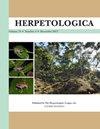Dipnet调查提供了透镜繁殖两栖动物幼虫的准确丰度估计
IF 1.1
3区 生物学
Q2 ZOOLOGY
引用次数: 0
摘要
摘要:几种水生采样技术通常用于检测和量化两栖动物幼虫。尽管许多技术已经标准化,但对方法之间的比较研究很少。我们采用了一种移除设计来调查使用箱式围栏的两栖动物幼虫的检测率,并评估了定时dipnet采样相对于13个春季水池中更定量的箱式围栏采样的可靠性。为了进行这些比较,我们研究了濒危的加利福尼亚虎蝾螈(Ambystoma californense;CTS)和太平洋树蛙(Pseudacris regilla;PTF)中体型较小、数量较多的蝌蚪的幼虫。根据N-混合物模型的估计,尽管CTS幼虫的大小和估计的丰度存在差异,但箱围采样捕获的CTS幼虫仅比PTF蝌蚪多5%。Dipnet采样在检测CTS幼虫方面比围栏采样更有效,而两种方法都能同样检测到PTF蝌蚪。我们发现,通过双网采样估计的CTS幼虫密度与通过更定量的围栏采样计算的CTS幼虫的密度之间存在很强的关系(R2=0.92),这表明双网采样是相对丰度的可靠测量。我们得出的结论是,定时双网调查可以成为监测CTS种群以及其他慢食两栖动物种群的重要工具,特别是考虑到其相对效率可以在时间和空间上复制。本文章由计算机程序翻译,如有差异,请以英文原文为准。
Dipnet Surveys Provide Accurate Abundance Estimates for Lentic-Breeding Amphibian Larvae
Abstract: Several aquatic sampling techniques are commonly used to detect and quantify amphibian larvae. Although many techniques have been standardized, comparisons among methods have been poorly studied. We employed a removal design to investigate the detection rate of amphibian larvae using box enclosures and evaluated the reliability of timed dipnet sampling relative to the more quantitative box enclosure sampling across 13 vernal pools. For these comparisons, we studied larvae of the endangered California Tiger Salamander (Ambystoma californiense; CTS) and the smaller and more abundant tadpoles of the Pacific Treefrog (Pseudacris regilla; PTF). Based on N-mixture model estimates, box enclosure sampling captured only 5% more of the CTS larvae present than PTF tadpoles, despite disparities in their sizes and estimated abundances. Dipnet sampling was slightly more effective at detecting CTS larvae than was enclosure sampling, while both methods equally detected PTF tadpoles. We found a strong relationship (R2 = 0.92) between the densities of CTS larvae estimated from dipnet sampling and those calculated from the more quantitative enclosure sampling, indicating that dipnet sampling is a reliable measurement of relative abundance. We conclude that timed dipnet surveys can be an important tool for monitoring populations of CTS, and possibly other lenticbreeding amphibians, especially given its relative efficiency that can be replicated across both time and space.
求助全文
通过发布文献求助,成功后即可免费获取论文全文。
去求助
来源期刊

Herpetologica
生物-动物学
CiteScore
4.60
自引率
0.00%
发文量
27
审稿时长
>12 weeks
期刊介绍:
Established in 1936, Herpetologica is a quarterly peer-reviewed journal serving herpetologists, biologists, ecologists, conservationists, researchers and the scientific community. The journal contains original research papers and essays about the biology of reptiles and amphibians, and covers many relevant topics including: behavior, conservation, ecology, genetics, morphology, physiology and taxonomy.
 求助内容:
求助内容: 应助结果提醒方式:
应助结果提醒方式:


